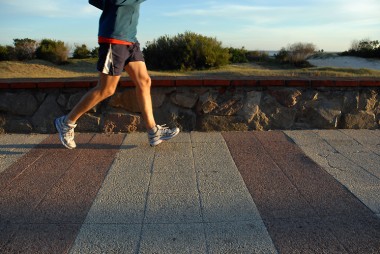 Many athletes develop shin splints, a condition called tibial stress syndrome by doctors. Whether you are running a marathon or just sprinting to catch the bus, you feel a throbbing or aching in your shins and that’s shin splints.
Many athletes develop shin splints, a condition called tibial stress syndrome by doctors. Whether you are running a marathon or just sprinting to catch the bus, you feel a throbbing or aching in your shins and that’s shin splints.
Shin splints are not a real medical condition but a symptom of an underlying problem.
This symptom could be the result of irritated and swollen muscles from overuse, stress fractures (tiny hairline breaks in the lower leg bones), over pronation from flat feet causing the arch of the foot to collapse and stretching of the muscles and tendons to occur.
How will I know if I have Shin Splints?
Shin splints are very common, causing around 20% of all running injuries. Most runners develop them from changing the type of surface they run on or after ramping up their workout intensity. This condition is also very common among dancers.
Shin splints cause an aching, dull type of pain in the front of the lower leg and some people feel it only when they exercise. Others feel it right after they have stopped exercising and then there are some people who have constant shin pain. This will all depend on the exact cause. The pain can be located in the front of the leg and to each of the sides of the lower leg. When swollen muscles irritate the nerves of the feet, they will go numb and get weak.
What are the Risk Factors for Shin Splints?
When you are at risk for shin splints and your legs start to ache, you may want to see your doctor. In order to diagnose shin splints, your doctor will probably ask you questions about risk factors and he may want to take some X-rays to see if there are any fractures in your legs. You may need a thorough physical exam and the doctor may want to do a bone scan. Sometimes, it is necessary for your doctor to run a series of tests to diagnose this problem.
Some risk factors for shin splints are:
- Running or jogging
- Dancing
- Flatfeet or rigid arches
- Military training
- Sudden increase in training
- New vigorous workout routine
How is Shin Splints Treated?
There are many different problems that can cause shin splints, but the treatment is generally the same, regardless of the cause. Here are some things your orthopedic specialist may prescribe or recommend:
Rest – Your doctor will likely take you out of sporting activities for a few weeks.
Ice – Icing the shin will reduce swelling and limit pain. You can do this for 20 minutes every three or four hours until the pain is gone.
NSAIDS – Non-steroidal anti-inflammatory drugs are useful to help with pain and take down inflammation. These are only recommended for a short period of time.
Arch Supports – Adding arch supports to your shoes will help flat feet.
Range of Motion Exercises – Your doctor will recommend exercises that will help shin splints.
Physical Therapy – Often times, the orthopedic specialist will order PT for you to strengthen the muscles in your legs.
Surgery – For some people, surgery is the only treatment option. Your doctor will decide if this option is right for you.
When will my Shin Splints feel Better?
There is no way for your doctor to known exactly when your shin splints are going to go away, because this will depend on what is causing them. People heal at different rates, too, so a general rule of thumb is two weeks. The most important thing for you to do is not exercise while you have shin splints so the problem doesn’t get any worse. Your shin splints are fully healed when:
- Your injured leg is as flexible and strong as your other leg.
- You can run, jog, sprint, and jump without pain.
- Your X-rays are normal or your stress fractures have healed.
How Can I Prevent Shin Splints?
Of course, the best medicine comes in the form of prevention. To prevent shin splints you can:
- Warm up before working out, making sure to stretch the muscles in your legs.
- Always wear shoes with good support and padding.
- Don’t run or play on hard surfaces like concrete.
- Stop working out as soon as you feel pain in your shins.
Find OSS on Facebook and follow on Twitter to keep up to date on new articles and news.

